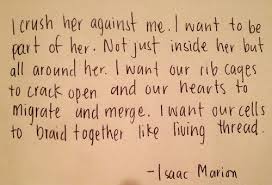My Young Adult Fiction and the Gothic module ‘Generation Dead’ begins on January 18th. The students are going to be following the blog and attending the workshops described below:
All over the country in the world of young adult fiction teenagers who die aren’t staying dead. This module will interrogate the new high school Gothic, exploring the representation of the undead or living dead (werewolves, vampires and zombies) in dark or paranormal romance. Texts range from Daniel Waters’s zombie trilogy to Isaac Marion’s Warm Bodies and Holly Black’s Coldtown. We’ll also look at examples of werewolf fiction (Shiver) and at the folklore inspired novels of Marcus Sedgwick. YA fiction has attracted some of the most gifted writers who address these themes as a means of confronting death or discrimination or to engage with faith and embrace the enduring power of love. We will be theorising folklore and grappling with undead issues such as the notion of free will, damnation and redemption, the sexualisation of early teens, the effects of prejudice and the politics of difference.
This module is dedicated to Sophie Lancaster who was beaten to death in a park for being a ‘goth’. Please read Simon Armitage’s Black Roses: The Killing of Sophie Lancaster on StudyNet before beginning the module (we will draw on this representation of gothic subculture and otherness in our sessions). Stamp Out Prejudice, Hatred, Intolerance Everywhere
Generation Dead is taught via two hour workshops on Mondays 9.00-11.00 (room R118), 1.00-3.00 (room N105).
Introductory workshop – Constructing Adolescence in Gothic Fictions
18th Jan. Neil Gaiman, Coraline; Catherine Spooner, ‘Teen Demons’, Contemporary Gothic, pp. 87-123; Alison Waller, Constructing Adolescence in Fantastic Realism, 1-27; Lisa Perdigao, ‘Transform, and twist and change: Deconstructing Coraline’, The Gothic Fairy Tale in YA Literature, pp. 102-122
Zombies and the Politics of Difference
25th Jan. Daniel Waters, Generation Dead; Clive Bloom, ‘Day of the Dead’, THES, 28th June, 2010; Joni Richards Bodart, ‘The Generation Dead Series’, They Suck, They Bite, They Kill, pp.177-187; Bill Hughes, ‘‘Legally Recognised Undead’: Essence, Difference, Assimilation in Daniel Waters’s Generation Dead’, Open Graves, Open Minds, pp. 245-264; Mark Currie, ‘Other’, Diffference, pp. 133-4.
Zom Rom Com: Love Your Zombie
1st Feb. Isaac Marion, Warm Bodies; Fred Botting, ‘Love Your Zombie: Horror, Ethics, Excess’, The Gothic in Contemporary Literature and Popular Culture, pp. 19-37; Sasha Cocarla, ‘A Love Worth Un-dying For’ Zombies and Sexuality: Essays on Desire and the Living Dead, pp. 52-71.
Folklore and Fiction: The Elusive Vampire
8th Feb. Marcus Sedgwick, My Swordhand is Singing; Dom Augustin Calmet, ‘A Treatise on the Vampires of Hungary and Surrounding Regions’, Vampyres, pp. 87-103; Vladimir Propp, ‘Folklore and Literature’, Morphology of the Folktale, pp.378-87; Marcus Sedgwick, ‘The Elusive Vampire: Folklore and Fiction – Writing My Swordhand is Singing’, Open Graves, Open Minds, pp. 264-276.
Gothic Romanced
15th Feb. Buffy the Vampire Slayer [episode 2.13, ‘Surprise’, episode 2.14 ‘Innocence’]; Stephanie Meyer, Twilight; Sam George, Buffy Handout; Chris Richards, ‘What Are We? Adolescence, Sex and Intimacy in Buffy the Vampire Slayer’, Continuum, 18 (2004), 121-37’; Anna Silver, ‘Twilight is Not Good for Maidens’, Studies in the Novel, 42.1 (2010), 121-136; Rhonda Wilcox, ‘‘Every Night I Save You’: Buffy, Spike, Sex and Redemption’, Why Buffy Matters, pp. 79-89; Anne Billson, ‘Love and Other Catastrophes’, Buffy the Vampire Slayer, pp. 46-61; Danielle McGeough, ‘Twilight and Transformations of the Flesh: Reading the Body in Contemporary Youth Culture’, Bitten By Twilight, pp. 87-102; Catherine Spooner, ‘’Gothic Charm School: or How Vampires Learned to Sparkle’; Sara Wasson and Sarah Artt, ‘The Twilight Saga and the Pleasures of Spectatorship, the Broken Body and the Shining Body’, Open Graves, Open Minds, pp. 146-164, 181-224.
22nd-28th Feb. Reading Week
Intertextuality and the Female Vampire
29th Feb. Alyxandra Harvey, My Love Lies Bleeding; Carol A Senf ‘Daughters of Lilith: Women Vampires in Popular Literature’, The Blood is the Life: Vampires in Literature, pp. 199-217; Sam George, ‘Intertextuality’ (handout); Brothers Grimm, ‘Snow White’, Classic Fairy Tales, pp. 83-90
Consuming Gothic
7th March. Holly Black, The Coldest Girl in ColdTown; Rob Latham, ‘Youth Fetishism’, Consuming Youth, pp. 26-69;, Catherine Spooner, ‘Subcultural Style’, ‘Gothic Shopping’, ‘The Pursuit of the Undead Dollar’, Contemporary Gothic pp. 92-114, 145-153; Rhona Nicol, ‘Monstrosity will be called for’ Holly Black’s and Melissa Marr’s Urban Gothic Fairy tale Heroines’, The Gothic Fairy Tale in YA Literature, pp. 165-181.
Animal/Human Boundaries
14th March. Maggie Stiefvater, Shiver; Sabine Baring-Gould, ‘Folklore Relating to Werewolves’, ‘Natural Causes of Lycanthropy’, The Book of Werewolves, pp.77-97, 98-113; Chantal Bourgault Du Coudray, ‘Women who Run With Wolves’, The Curse of the Werewolf, pp. 112-130; ‘Joni Richards Bodart, ‘The Wolves of Mercy Falls Trilogy’, They Suck, They Bite, They Eat, They Kill, pp. 113-122; Kimberly McMahon-Coleman, ‘The True Self, Animal or Human’, Werewolves and Other Shapeshifters in Popular Culture, pp. 31-37; https://www.opengravesopenminds.com/critical-thoughts/bill-hughes-but-by-blood-no-wolf-am-i-language-and-agency-instinct-and-essence-transcending-antinomies-in-maggie-stiefvaters-shiver-series/
Wolf Children and Human Nature
21st March. Marcus Sedgwick, The Dark Horse; Lucien Malson, ‘Three Main Types of Wolf Children’, Wolf Children and the Problem of Human Nature, pp. 62-82; Matt Beresford, ‘The Fits of Fury: The Wolves of Germania’, The White Devil, pp. 57-84; Greg Garrard, ‘Looking at Animals’, Ecocriticism, pp. 152-180; ‘Chronotopes and Heritage, Time and Memory’, Kimberley Reynolds, ed., Contemporary Children’s Literature, pp. 156-172
Easter Break 25th March – 8th April
Animal Bridegrooms and Gothic Fairy Tales
11th April. Robin McKinley’s, Beauty; Jeanne-Marie Leprince de Beaumont, ‘Beauty and the Beast’, Maria Tatar, ed., The Classic Fairy Tales, pp. 25-42; ‘Female Coming of Age, the Mirror Stage and the Absence of Mirrors in Robin McKinley’s Beauty’, The Looking Glass, 8.1, (2004); Bruno Bettelheim, ‘The Animal Groom Cycle of Fairy Tales’, The Uses of Enchantment, pp. 277-311; Charles Perrault, ‘Donkeyskin’, Joseph Jacobs, ‘Catskin’; Angela Carter, ‘The Tiger’s Bride’, Classic Fairy Tales, pp. 109-177, 122-125, 50-66.
Dark Fairies: Shakespeare’s Puck and the Contemporary Never Never 18th April. Julie Kagawa, The Iron King; William Shakespeare, ‘A Midsummer Night’s Dream’, The Norton Shakespeare, Introduction, pp.805-813, Act 2. Scene 1, pp. 819-827, Act 5. Scene 2, ‘Epilogue’, p. 860. Julia Briggs, ‘Fairy Realms’, ‘Changelings and Midwives’, ‘The Poets’, ‘Fairy Beasts’, The Fairies in Tradition and Literature, pp. 14-30, 84-98, 136-46, 183-204; Joseph Jacobs, ‘The King O’ The Cats’, More English Fairy Tales, pp. 156-159. Roz Kaveney, ‘Dark Fantasy and Paranormal Romance’, Cambridge Companion to Fantasy Literature, pp. 214-224; ‘Environmentalism’, ‘Deep Ecology’, Greg Garrard, Ecocriticism, pp. 21-26. Sam George ‘Iron King Handout’ ; https://www.opengravesopenminds.com/critical-thoughts/bill-hughes-landscapes-of-romance-generic-boundaries-and-epistemological-dialectics-in-the-paranormal-romance-of-julie-kagawas-the-iron-king/
Examining Otherness: Revision Workshop
25th April.


